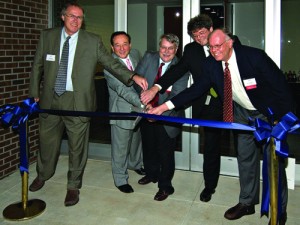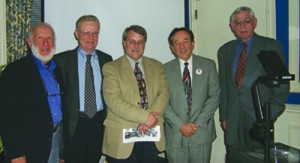The National Institute of Statistical Sciences Celebrates 20-Year Anniversary
Affiliates program celebrates 10th
The National Institute of Statistical Sciences (NISS) simultaneously celebrated the 20th anniversary of its creation and the 10th anniversary of the formation of its affiliates program.
The pre-history of NISS goes back to a 1984 meeting of the Institute of Mathematical Sciences at Lake Tahoe. There, a number of visionaries realized how much the statistical sciences would benefit from deeper engagement in cross-disciplinary research and that an institute was a key component to making this happen. A proposal was sent to the National Science Foundation (NSF) for a panel study on cross-disciplinary research. The resulting report, coauthored by Ingram Olkin and Jerome Sacks, was published in 1988.

From left: Jim Berger (SAMSI), Dan Solomon (NCSU and NISS Board of Trustees), Alan Karr (NISS), Peter March (NSF), and Jim Landwehr (Avaya and NISS Board of Trustees)
Responding to the report, the ASA conducted a feasibility study to assess the scientific and financial viability of an institute. The result was positive, and a site selection competition ensued. Proposals were made by several locations across the United States, but the selection committee chose the one from the Research Triangle Park (RTP) region of North Carolina—one of the most statistically active areas in the country. Three major research universities (Duke, North Carolina State, and The University of North Carolina at Chapel Hill), all of which have outstanding statistics and biostatistics departments, provided release time for faculty and students to participate in the fledgling institute’s activities.
The Research Triangle Foundation offered a six-year start-up grant, and the Triangle Universities Center for Advanced Studies, Inc. (TUCASI) provided a 99-year lease on a five-acre building site for $1 per year. The Research Triangle Institute (now RTI International) provided initial space and computer support at no cost to NISS. SAS Institute offered free SAS software to the initial start-up group. And, perhaps most important, the state of North Carolina provided funds for construction of a building for NISS.

From left: Ingram Olkin, Jon Kettenring, Alan Karr, Dan Solomon, and Jerry Sacks at the 10th anniversary celebration of NISS
The founding ceremony was held December 3, 1990, with Gov. James Martin as keynote speaker. Daniel Horvitz of RTI became the interim executive director, and Albert Bowker of the University of California, Berkley, became the first chair of the board of trustees. Jerome Sacks was appointed founding director in 1991, and Alan Karr became associate director in 1992.
NISS rapidly began working on projects funded by several government agencies, including the U.S. Environmental Protection Agency, NSF, and the National Center for Education Statistics (NCES). These featured deep engagement of postdocs, which has become a defining trait of NISS.
NISS moved into its own building on the TUCASI campus in 1997. In 2000, Jerry Sacks retired and Alan Karr took over as director.
In 2000, NISS created the affiliates program to address challenges arising in government and industry, adding “cross-sector” to cross-disciplinary as a focus. By year’s end, there were more than 40 members from industry, government, and academia. In 2005, the ASA recognized the affiliates with its SPAIG (Statistical Partnerships among Academia, Industry, and Government) Award. Today, the affiliates program is inseparable from the identity of NISS.
In 2002, the establishment of the Statistical and Applied Mathematical Sciences Institute, the partner of NISS and co-occupant of the building, led to a richer scientific environment, new theory and methodology for NISS projects to follow up on, and—in 2008—completion of an addition to the building.
At age 20, NISS is more vibrant and active than ever, with several major research projects under way, including studies with the National Agricultural Statistics Service, NCES, Project Talent, and a syndromic surveillance project involving multiple universities and funding sources.
As NISS continues to build its ties with the federal statistical agencies, it is in the midst of strengthening and systematizing its Washington presence. Already, three postdocs and two employees are based there. Starting in 2011, Nell Sedransk, associate director, will lead the DC presence. Reflecting NISS’s ongoing growth, an RTP-based deputy director is being recruited.
The affiliates program continues to thrive, as well. Recently, affiliates clusters were created to focus attention and promote networking among people from affiliates with similar interests.
The next 20 years of NISS promise to be as exciting and diverse as the first. The statistics community will continue to play a vital role in serving the nation, and NISS intends to remain at the forefront of mobilizing research and delivering answers.

















